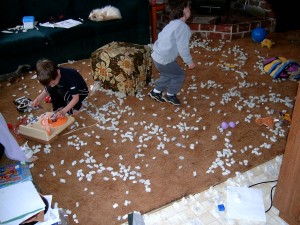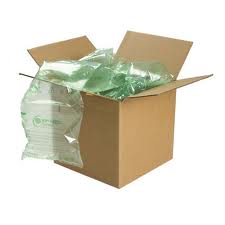
The sales process followed with this customer exemplifies the value that Pregis can provide to an end user. It began with a distributor wanting information on one product but was won with application based selling and a focus on the customer’s organizational goals including:
- Protective packaging solutions
- Operational excellence
- Best total cost‐in‐use
- Sustainable solutions
- Positive brand image
For several years, a major U.S. retailer had been using a combination of Geami and cornstarch‐based, loose‐fill peanuts to protect internet orders shipped from its five distribution centers (DCs). Many of these products were fragile items such as housewares, glass and china.
 Geami was used to wrap individual order components. Loose‐fill peanuts were used to create a twoinch bottom “bed” in the case before the items were placed inside. The shipper was then filled to the top with additional loose fill prior to case sealing.
Geami was used to wrap individual order components. Loose‐fill peanuts were used to create a twoinch bottom “bed” in the case before the items were placed inside. The shipper was then filled to the top with additional loose fill prior to case sealing.
Tagging 2010 as the “year of the customer,” the retailer wanted to find better protective packaging solutions to address shopper concerns. A Pregis distributor located in New Jersey‐ got the ball rolling and testing quickly expanded into high volume locations in Georgia and California.
Pregis proposed that the customer use AirSpeed Hybrid Cushioning to replace the messy loose fill and transition to Microfoam to wrap the materials.
By performing pack outs and drop test analysis, Pregis was able to show that by switching to Microfoam, the customer could reduce the wrap required from four times to two. This not only significantly reduced the amount of primary cushioning material, but also decreased the pack time by 30 seconds per order. Pregis was able to demonstrate that the combination Microfoam/HC approach reduced damage by a significant 14%. The Pregis solution required less physical space within the case, so the retailer was able to reduce the shipper sizes used by their DCs.
Pregis reviewed the customer’s entire packing process instead of limiting the audit to just the packing materials. The proposed HC system was supported by a custom‐designed delivery system for one of the distribution centers.
Continuing on the holistic sales path, the team inquired about the time and resources required for storage and handling of the current protective packaging products. Pregis was able to show that transitioning to a hybrid cushioning solution could reduce the number of man hours needed to handle inbound shipments by 1790 hours/year. This was accomplished by eliminating 702 deliveries, which reduced freight costs and improved the carbon footprint.
One of the retailer’s most valuable assets‐‐its employees‐‐also benefited by the material switch. They no longer had to contend with messy loose‐fill particles which clogged the delivery systems in warmer, more humid weather nor did they experience paper cuts from handling the Geami. An average of 50 hours/week of labor costs was eliminated by the conversion. In addition, the customer was able to free up a significant amount of valuable warehouse space.
 The ability to create a proprietary delivery system which improved the customer’s process, improved labor and better protected products, made it possible for Pregis to secure a long‐term agreement.
The ability to create a proprietary delivery system which improved the customer’s process, improved labor and better protected products, made it possible for Pregis to secure a long‐term agreement.
Best total cost‐in‐use: The combined impact of the material and labor savings, operational improvements and damage reduction, made this a compelling decision. The Pregis solution was put in place at three DCs at the end of 2010. An additional two DCs are in the process of being transitioned.
Environmental solutions: The customer’s current packaging materials had been chosen based on their environmental benefits. However, the HC and Microfoam combination was actually found to be equally, if not more, environmentally responsible when the following advantages were considered.
- Source reduction – consume significantly less packaging materials, reduce material waste in landfills
- Reduced inbound freight costs by 2/3 – saves energy and reduces carbon footprint
- Reduced outbound freight costs by downsizing the shipping containers and improving truck cube
- Microfoam is photodegradable
- HC Cushions are reusable and the film is 100% recyclable (#4 LDPE)
Positive brand image: The company had been receiving consumer complaints about the messy loose‐fill and receiving damage reports—particularly on its more fragile products such as china and other delicate housewares.
The HC and Microfoam solution has a much more appealing look. Microfoam has a clean, white appearance and HC cushioning materials are transparent and mess‐free. Customers no longer run the risk of throwing away items that were left in the box because they were hidden under a pile of messy loose fill.






